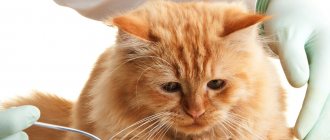5789Pavel
1
Many pet owners are wondering whether cats can be given Paracetamol. There can only be one answer here - you should never, under any circumstances, give this medicine to your pets. Paracetamol is poisonous for cats, as any veterinarian will confirm.
Animals should be treated by a specialist; self-medication can be fatal. Especially in cases where compassionate owners try to help their pets on their own, giving them medications from their own, “human” home medicine cabinet. Giving a cat Paracetamol means putting the animal in mortal danger.
© shutterstock
Content
1. General description 2. About medicinal properties and prohibitions 3. Poisoning and first aid 4. How to replace Paracetamol 5. Home remedies for reducing fever
When treating pets, medical (“human”) drugs are often used, so at the first sign of illness in a pet, owners often ask the veterinarian what medications can be given to alleviate the animal’s condition, and in particular, whether the cat can be given Paracetamol at a fever.
Prevention
Of course, the main preventative measure is to prevent your cat from accessing your first aid kit. A cat is a naturally curious animal, and it tries to explore its territory as much as possible. Therefore, your first aid kit should be in a place that is as inaccessible to your cat as possible.
If your cat needs pain medication, never use human medicine. Today, there is a large selection of veterinary pain medications for cats that are both highly effective and well tolerated.
About medicinal properties and prohibitions
Paracetamol is considered a vital and essential medicine, according to the World Health Organization. This is a widespread analgesic that is used for therapeutic purposes to treat fever, relieve headaches, dental and postoperative pain, joint pain, and in oncology to relieve pain.
However, not so long ago there was widespread information in the press that paracetamol has many dangerous side effects, in particular liver toxicity. There is also an assumption that paracetamol increases the risk of developing diseases of the gastrointestinal tract, in particular gastric bleeding. In this regard, doctors recommend carefully monitoring the dosage of drugs containing paracetamol, and veterinarians unanimously say: paracetamol is strictly prohibited for cats!
Even if in humans it can cause liver damage, even death (statistics say that almost half of cases of liver failure are associated with an overdose of paracetamol), then in pets the liver is generally unable to break down and remove acetaminophen from the body, which causes intoxication of the body and the death of the animal .
Paracetamol (acetaminophen) is included in many medications, and all of them are prohibited for veterinary use. Such medications include:
- Paracetamol;
- Panadol;
- Efferalgan;
- Anvi-Max;
- Askofen;
- Ibuklin and others.
In small doses, paracetamol is not dangerous for humans, so these drugs are widely used in the treatment of colds and fever, but cats should not be given such medications, even in case of emergency.
A single toxic dose for cats is 50-100 mg/kg (1 tablet may contain 200 or 500 mg of paracetamol). However, intoxication of the body can occur with a much smaller dose. In veterinary practice, there have been cases of death of animals at a dose of 10 mg/kg.
Precautions during treatment
We have seen that dogs can only take paracetamol under veterinary supervision, so to avoid accidents that could have fatal consequences, the following precautions are recommended:
- Never treat our dog unless it is under veterinary prescription.
- Always keep medications away from our dogs.
- When we are forced to treat them, we must do so by scrupulously following our veterinarian's instructions regarding the dose and duration of treatment.
- If we suspect that our dog may have ingested a large amount of paracetamol or we have given it, we must take it to the vet immediately.
This article is for informational purposes only, we are not in a position to prescribe veterinary procedures or make any diagnoses. We invite you to take your pet to the veterinarian if there are any conditions or discomfort.
Poisoning and first aid
After taking Paracetamol or other drugs containing acetaminophen, clinical signs of intoxication may appear within the first two to four hours.
Symptoms of paracetamol poisoning in cats:
- labored breathing;
- depressed state;
- vomit;
- swelling of the muzzle and limbs;
- yellowing of the skin;
- dark chocolate color of urine;
- change in the color of the gums and whites of the eyes - they acquire a bluish or yellowish tint.
Important!
If you notice these signs or suspect acetaminophen poisoning, you should contact your veterinarian immediately. The sooner treatment is started, the greater the chance of a favorable outcome.
The above symptoms indicate methemoglobinemia - an increased amount of methemoglobin (hemoglobin with ferric iron). It cannot bind oxygen and, accordingly, transport it to tissues. With methemoglobinemia, a cat can die within 18-36 hours. The pet can be saved only by urgently starting treatment. It will be lengthy and expensive, and the animal will require good care.
Effect on the cat's body
All veterinarians are unanimous in their opinion that cats should never be treated with this drug. If the animal has a fever or is not feeling well, it is prohibited to give it Paracetamol. It is necessary to immediately show your pet to a veterinarian, who will prescribe the appropriate medication.
Once in a cat's body, Paracetamol has a strong toxic effect. Veterinarians believe that it is enough for a pet to swallow only 10 mg of this medication, and within a few hours signs of poisoning may appear, and within 24-36 hours the animal will die if it is not given medical assistance.
If the drug enters the cat’s body:
- oxygen starvation begins, as the ability of red blood cells to transport oxygen decreases;
- hypoxia leads to excessive stress on the heart muscle, which is forced to work to the limit, which quickly leads to cardiomyopathy;
- the cat’s small liver suffers from toxic effects, hepatocytes begin to quickly deteriorate;
- the functions of the kidneys and urinary tract are impaired.
If the animal is not provided with immediate veterinary care, its internal organs may cease to function completely in a matter of hours.
How to replace Paracetamol
There are medications on the veterinary drug market with antipyretic and analgesic properties that are safe for pets. However, first of all, the cause of the increase in temperature must be established. Only a veterinarian can do this professionally, and at home you should leave the animal alone for a while, providing access to clean water. After half an hour or an hour, if the temperature has not dropped and there are signs that the animal is unwell, take the pet to the clinic or invite a specialist to your home.
Important!
A cat's body temperature above 41°C causes critical loss of fluid from the body and can provoke swelling of the brain and life-threatening damage to internal organs.
First aid:
- ensure peace and access to fresh water;
- in case of heat stroke or too high a temperature, you can moisten the animal’s fur with water;
- ensure the flow of fresh cool air into the room;
- if dehydration and lack of thirst (the cat refuses to drink), add water using a pipette or syringe without a needle.
Important!
Regidron will help restore water balance and alleviate the condition of a sick animal.
Among the medications that will help reduce your pet’s temperature and relieve pain, the most often chosen are drugs based on ketoprofen or meloxidil. Ketoprofen is a propionic acid derivative that has analgesic, antipyretic, and anti-inflammatory properties. Ketoprofen is included in the following veterinary drugs:
- Ainil - 1% solution is used subcutaneously for cats as an antipyretic, as well as to relieve pain of any etiology;
- Ketoprofen – 10% solution, has an antipyretic effect, relieves pain and inflammation;
- Flexoprofen is used to reduce body temperature in cats, as well as in the treatment of acute, subacute and chronic inflammatory diseases accompanied by pain.
The following veterinary drugs also have antipyretic and analgesic properties:
- Vetalgin;
- Ketoquin;
- Rimadyl and others.
Meloxicam is prescribed to cats for diseases of the musculoskeletal system, which are accompanied by severe pain and inflammation. The drug has anti-inflammatory, analgesic and antipyretic properties. An analogue of the drug is Meloxidil.
What measures need to be taken
As soon as it becomes clear that the cat has swallowed a Paracetamol tablet, you need to take it to the veterinary clinic so that it is not too late. An animal may swallow the medicine accidentally if the package of tablets was left unattended and accessible to the animal.
In case of any poisoning, including Paracetamol, first of all it is necessary to induce vomiting. However, it is not always possible to do this on your own. It is better to urgently give your cat an activated carbon tablet before going to the veterinarian.
You should prepare for the fact that treatment may be serious, lengthy and expensive. Because paracetamol poisoning causes damage to vital organs.
At the veterinary clinic, the doctor will rinse the cat’s stomach, carry out urgent intravenous diffusion, oxygen therapy, and prescribe medications to protect the stomach, support the liver and kidneys, and vitamin C. It will be necessary to monitor the animal’s body temperature and the state of metabolic processes in the blood.
The complexity of treatment depends on the condition of the animal and what dose of Paracetamol the cat swallowed and how much time has passed since that moment.
You also need to be prepared for the fact that as a result of poisoning, the cat’s liver and kidney functions will be impaired for the rest of its life, even after successful treatment. Therefore, do not deprive your pet’s health by giving it any pills without first consulting a specialist.
Having pets in the house is a big responsibility. But in addition to a good diet and leisure time for the furry pet, the owner must monitor the animal’s health. Cats, like other animals, sometimes experience troubles such as fever.
Fever in cats is a problem that the animal owner must first solve. This symptom may be a sign of a more serious problem and should not be ignored.
A cat's normal body temperature at rest is between 27 and 39 degrees Celsius. It is curious that larger breeds often have temperatures slightly lower than their smaller counterparts.
Why does my pet have a fever? There is no clear answer to this question. Kittens, like people, have many reasons to catch a fever.
The most common reasons why a cat may have a high fever:
- Disease. Body temperature may increase as a result of inflammation occurring in the body. Moreover, at first it may not be noticeable from the outside. Symptoms may develop slowly. In addition to inflammation, high fever can occur as a result of an infectious disease. In both cases, the thermometer will show about 40 degrees.
- Food poisoning. Murks do not always keep track of what they are about to swallow. After eating spoiled food or drinking fresh milk, the mug may feel unwell, which will be indicated to the owner by its drooping appearance and the thermometer reading.
- As a result of overheating in the sun. Direct sunlight is harmful not only to humans, but also to animals. If a Murka has been in the scorching sun for a long time without the possibility of shelter, it is likely that its body temperature will rise.
There are also situations when an increase in body temperature can be considered normal:
- Temperature jumps after active games. Kittens are very active and restless, so it is quite possible that after a long run the baby’s temperature will be a degree or one and a half higher than normal.
- In nursing kittens, there is also a jump in indicators after a hearty lunch.
- Pregnant women have a slightly elevated body temperature. Therefore, you should not worry and often measure indicators if Murka feels normal.
- Stressful situations can cause surges. A cat that has undergone a long trip to the veterinary clinic may develop an elevated temperature even in a healthy state. This is somewhat puzzling for owners who, for example, took their pet to the hospital for vaccination. Only an absolutely healthy animal can be given an injection, so the pet must be left alone for a while and allowed to calm down in order to accurately determine the cause of the “warming up”.
Situations in which it is necessary to measure a pet’s temperature:
- poor appetite
- digestive disorders - vomiting, diarrhea,
- lethargy of the animal,
- difficulty breathing, cough, wheezing,
- fever.
Lethal dose of the drug for cats and dogs
After paracetamol poisoning, there is a chance that the dog will survive, but the death of the animal cannot be ruled out. All further forecasts directly depend on the dosage of paracetamol that was given to the dog. In addition, it is necessary to take into account the breed of the pet, since small dogs are more susceptible to the drug, this also applies to cats.
What is the lethal dose of paracetamol for a dog? 500 mg of the drug per 1 kg of pet weight can cause severe intoxication and lead to death. It is also necessary to remember that an increase in liver enzymes 12 hours after consuming the tablets is a good reason to consult a veterinarian.
Attention! If the dosage turns out to be non-lethal for the dog, the owner needs to know that complete recovery of the liver will take at least three months. In addition, each pet’s body is different, so no doctor can give an accurate prognosis.
What are the clinical signs of paracetamol poisoning
After the cat swallows the tablet, negative consequences develop quite quickly. It can take from one to four hours, and the owner of the animal will see that the pet has become very ill. Here are the signs :
- Weakness, depression - the cat hides in a dark place that is safe from its point of view and lies without leaving there.
- The mucous membranes darken.
- The cat is breathing quickly.
- The urine becomes dark in color, almost chocolate.
- Vomit.
- Swelling of the front legs and muzzle.











